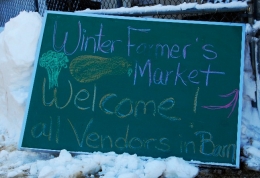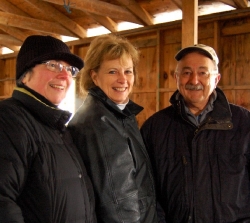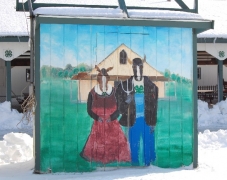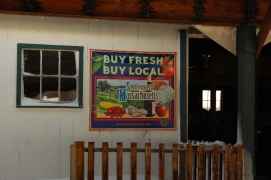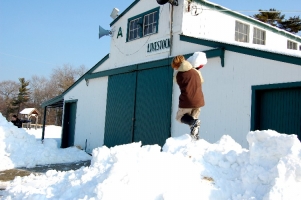Archive for February 2011
Marshfield Farmers Market Public Secret
Like Poe’s Purloined Letter, Marshfield’s Winter Farmers Market is hiding in plain sight.
Building on the steadily growing popularity of farmers markets locally, regionally and nationally, the folks who bring you the annual Marshfield Fair (Marshfield Agricultural and Horticultural Society) converted a corner of the fairgrounds into a Farmers Market that runs throughout the summer and fall harvest seasons (June-October). The Fair itself, a highlight of Marshfield’s summer, was founded in 1867.
Growing and harvesting a tradition
2010 marked the 5th season of the Marshfield Farmers Market. The summer market is establishing a new tradition for locavores and community farmers.
Late in 2010, they took it another step — converting the fairgrounds’ 4-H Club shed into a frosty, enclosed market for winter shoppers. It began as a pre-holiday event in November, 2010.
“It’s an experiment,” says Market Manager Karen Biaginni (pictured here with her team of Janet Scribner and Bill Frugoli). The result? So far so good.Following their early success, they added dates for January and February 2011 – next one is Saturday, February 26. (South Shore citizens take note!)
Market Day, January 2011
We stopped by the market on Saturday, January 29, which turned out to be one of the few sunny days in an otherwise messy month. Inside the 4-H barn we made the rounds.
First stop was Rise and Shine – a community supported agriculture (CSA) farm in Marshfield, run by Marta and Doug MacFarland. We selected from a variety of fresh root vegetables (onions, acorn squash, cabbage, small potatoes, turnips, rutabaga and popping corn on the cob). You can order in advance from their website and join their mailing list, too. Fan Carolyn Housman (Marshfield, MA) stated “I am really turned off by grocery store waxed and soft turnips when I can buy it from Marta.” We bagged colorful dwarf onions and a few squash.
[Not a valid template]
Tending to local agriculture
Marshfield Farmer’s Market enjoys membership in the Southeast Massachusetts Agricultural Partnership (SEMAP), an organization formed in 1998 to promote regional stewardship of agricultural lands (and aquaculture). According to their website
SEMAP was a creation of necessity, as there was a void in our part of the commonwealth. SEMAP became the organization providing a comprehensive source to help the region’s farmers and aquaculture operators navigate the many agencies and organizations that provide support and resources to farming operations in the region. (Bristol, Plymouth and Barnstable Counties)
Bringing it home
I was seduced by cinnamon from Guiseppe’s Cakes (Hanover, MA) , and chatted with owner Joseph Perella. To qualify for a spot in the market your offerings must be locally produced (this ain’t no flea market, baby) and Joe is proud of his product. I chewed through a tasty cinnamon twist — sweet and fresh, although I was hoping for the hard-to-find flaky variety. “My specialty is my cakes,” he explained. And he had the goods to prove it.
I munched and meandered down the aisle to the outpost for Open Meadow Farm (Lunenburg, MA), producer and purveyor of pasture-raised organic meat. Robin and Charles Dance get help serving customers from daughter Rebecca. Open Meadow Farm often takes orders in advance of market day from a growing band of happy customers who won’t be disappointed. Finally I know the answer to “where’s the beef!” [Not a valid template]
Psssst — Marshfield has a market, Pass it on
While most of the action occurs in the summer market (lots of produce, live music, crafts, bigger crowds), the winter market brings out true believers. It’s a great new tradition for our neck of the woods. But don’t take my word for it — bundle up and check it out yourself. For more information tell ’em to put you on their mailing list — jgscribner @ hotmail.com
So, how do you satisfy your locavore? Add a comment and share your sustainable story!
Ajuga: weed of woe
I’ve never cared much about managing a lawn. The reward/effort ratio seems backwards to me. In fact, I harbor a conspiracy to reduce and replace grassy areas with (you guessed it) more garden. We on the home management committee periodically debate this topic.
Discovering the verdant pest
One spring, around ten years ago, I discovered a new member of lawn flora with a viney habit and spikes of small, blue flowers. Like everything else in the lawn, this was not my doing. It began to spread.
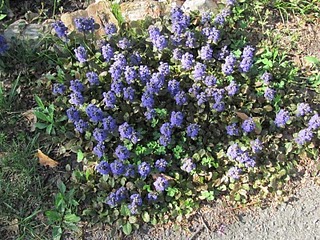
Spiky blue flowers of Bugleweed (ajuga reptans)
When I happened upon it in a plant catalog, my viney newcomer got a name: Bugleweed (ajuga reptans). This dainty looking plant is for sale!
Check out Dave’s Garden – people buy it, sell it, trade it and propagate it! Please don’t.
It continued to spread.
Consequences of ignorance
As I ignored it, the ajuga was emboldened to form denser patches, entirely displacing the turf in some spots. Still, lawn is lawn. What, me worry? But then it turned nasty. Its runners crossed the sacred boundary between lawn and garden and never looked back. It had my attention now. “Invasive” is too genteel a word for this mindless marauder.
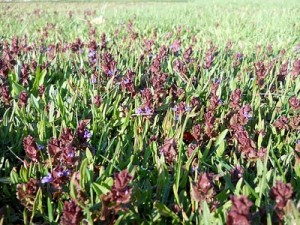
Bugleweed (ajuga reptans) thrives in my lawn and garden
The enemy within
De-ajuga-ing is an art form. You (easily) spot an invading runner and you very gently pull — it breaks if you tug too hard, which misses the whole point, and risks further colonization at the break point. Like a hydra.
So, you trace its path carefully and gently lift it from the soil and usually end up with a stringy yard or two (meters) of connected stems that extended from the original clump or runner.
I often let the weed pile sit on the patio til it bakes to death. Much safer than adding it to the compost pile uncooked.
If you don’t mind the Sisyphisian nature of it, this activity can continue for as long as you like because the stuff is everywhere. De-ajuga-ing can even be satisfying, the way most weeding can be. But don’t expect to eradicate it. Pure folly.
When I’m in the thick of gardening-in-the-moment (see Hyperfocusing…), I might just as easily be extracting ajuga runners as pruning, de-bugging, or planting.
Roses are red, violets are blue (or white)
I fondly remember spending my weeding time de-violet-ing. Those were simpler times. While I still pull the occasional violet clump, it’s like greeting an old friend with whom you once had a quarrel. Closer. Will I ever feel the same about ajuga? Heavens, what a thought.
Share a comment about your weed of woe!
